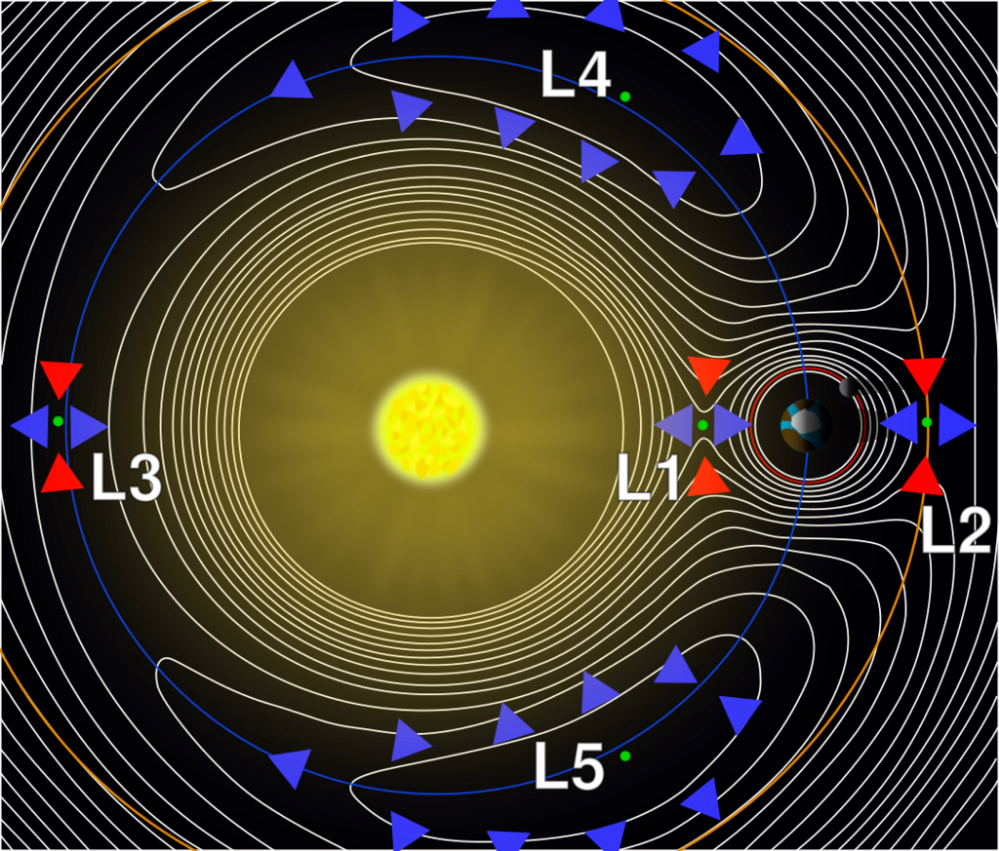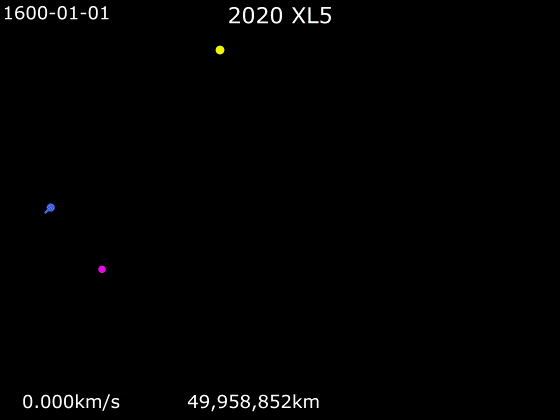
| Version | Summary | Created by | Modification | Content Size | Created at | Operation |
|---|---|---|---|---|---|---|
| 1 | Sirius Huang | -- | 876 | 2022-10-17 01:42:09 | | | |
| 2 | Sirius Huang | Meta information modification | 876 | 2022-10-17 05:07:02 | | |
Video Upload Options
2020 XL5 is a near-Earth asteroid and Earth trojan discovered by the Pan-STARRS 1 survey at Haleakala Observatory, Hawaii on 12 December 2020. It oscillates around the Sun–Earth L4 Lagrangian point (leading 60°), one of the dynamically stable locations where the combined gravitational force acts through the Sun's and Earth's barycenter. Analysis of 2020 XL5's trojan orbit stability suggests it will remain around Earth's L4 point for at least four thousand years until gravitational perturbations from repeated close encounters with Venus destabilize its trojan configuration. With a diameter about 1.2 km (0.75 mi), 2020 XL5 is the second Earth trojan discovered and is the largest of its kind known, after 2010 TK7.
1. Discovery
2020 XL5 was discovered by the Pan-STARRS 1 survey at Haleakala Observatory, Hawaii on 12 December 2020. It was first observed in the constellation Crater at an apparent magnitude of 21.4.[1] The asteroid was moving at an on-sky rate of 3.02 arcseconds per minute, from a distance of 0.68 AU (102 million km; 63 million mi) from Earth.[2]
The asteroid was subsequently listed on the Minor Planet Center's Near-Earth Object Confirmation Page (NEOCP) as P11aRcq.[3] Over two days, follow-up observations were carried out by the Višnjan Observatory (L01), ESA Optical Ground Station (J04), and Cerro Tololo Observatory (807). The asteroid was identified in earlier Mount Lemmon Survey (G96) observations from 26 November 2020. The listing was confirmed and publicly announced as 2020 XL5 on 14 December 2020.[1]
2. Orbit and Classification

The orbit of 2020 XL5 is well-known with an uncertainty parameter of 0 and a long observation arc over 8 years. The asteroid has been identified in several precovery observations by various sky surveys, including Pan-STARRS, from dates as far back as December 2012.[4][5]
2020 XL5 orbits the Sun at an average distance of 1.001 AU once every 365.8 days, or approximately 1 Earth year. Its orbit has a high eccentricity of 0.388 and an inclination of 13.8° with respect to the ecliptic plane. Over the course of its orbit, its distance from the Sun ranges from 0.61 AU at perihelion to 1.39 AU at aphelion, crossing the orbits of Venus and Earth. Since its orbit crosses that of Earth's while having a semi-major axis greater than 1 AU (by a small margin), 2020 XL5 is classified as an Apollo asteroid.[4]
2.1. Trojan Orbit



Trojan objects are most easily conceived as orbiting at a Lagrangian point, a dynamically stable location (where the combined gravitational force acts through the Sun's and Earth's barycenter) 60 degrees ahead of (L4) or behind (L5) a massive orbiting body, in a type of 1:1 orbital resonance. In reality, they oscillate around such a point.[6]
On 26 January 2021, amateur astronomer Tony Dunn reported that 2020 XL5's nominal trajectory appears to be librating about Earth's leading L4 Lagrangian point, suspecting it to be an Earth trojan.[6] Subsequent analysis confirmed modeling stability for at least several thousand years into the future based on existing orbital parameters.[7][8] This would make 2020 XL5 more stable than the prototype L4 Earth trojan 2010 TK7, which is potentially unstable on timescales of less than 2,000 years.[9] Additional follow-up observations and precoveries confirmed 2020 XL5's trojan nature, and showed that it will leave trojan orbit at least 4,000 years into the future.[5][10] Numerical simulations indicate that 2020 XL5 was likely captured into the L4 Langrangian point since the 15th century.[10]
2020 XL5's high orbital eccentricity results in wide, tadpole-shaped oscillation paths in a corotating reference frame with Earth and its Lagrangian points. Although the asteroid crosses Venus's orbit with a minimum orbit intersection distance (MOID) of 0.0273 AU (4.1 million km; 2.5 million mi),[11] perturbations by the planet are currently negligible since its nominal orbit brings it either too high or too low from the plane of Venus's orbit.[12] Venus's influence on 2020 XL5's orbit will become greater over time as their longitudes of the ascending node precess over hundreds of years, lowering 2020 XL5's Venus MOID and eventually destabilizing its trojan orbit by sending it to Earth's L3 point in several thousand years.[12]
3. Physical Characteristics
Photometric measurements of optical observations from 2020–2021 show that 2020 XL5 exhibits a color resembling that of carbonaceous C-type asteroids. Assuming that 2020 XL5's phase curve behaves similarly to those of C-type asteroids, the absolute magnitude (H) of the asteroid is 18.6, which corresponds to a mean diameter about 1.18 km (0.73 mi) for a typical C-type asteroid's geometric albedo of 0.06.[5] This makes 2020 XL5 the largest Earth trojan asteroid known to date, being up to three times as large as the 0.3 km (0.19 mi)-sized 2010 TK7.[5]
Because 2020 XL5 is only visible at low altitudes in the sky during twilight, atmospheric distortions and scattered light from the Sun hinder accurate photometry of the asteroid's light curve, thus information about its rotation could not be determined.[5]
4. Exploration
Due to 2020 XL5's high orbital inclination, a rendezvous mission to the asteroid from low Earth orbit (LEO) would require a minimum total delta-v of 10.3 km/s (6.4 mi/s)—too high to be considered an ideal target for a low-energy trajectory. On the other hand, a flyby trajectory to 2020 XL5 from LEO could be more feasible with a minimum total delta-v of 3.3 km/s (2.1 mi/s).[5]
References
- "MPEC 2020-X171 : 2020 XL5". Minor Planet Electronic Circular. Minor Planet Center. 14 December 2020. https://minorplanetcenter.net/mpec/K20/K20XH1.html.
- "2020XL5 Ephemerides". Near Earth Objects – Dynamic Site. Department of Mathematics, University of Pisa, Italy. https://newton.spacedys.com/neodys/index.php?pc=1.1.3.1&n=2020XL5&oc=F51&y0=2020&m0=12&d0=12&h0=14&mi0=49&y1=2020&m1=12&d1=12&h1=15&mi1=24&ti=1&tiu=minutes.
- Gray, Bill (14 December 2020). ""Pseudo-MPEC" for P11aRcq". Project Pluto. https://projectpluto.com/neocp2/mpecs/P11aRcq.htm.
- "JPL Small-Body Database Browser: 2020 XL5". Jet Propulsion Laboratory. https://ssd.jpl.nasa.gov/tools/sbdb_lookup.html#/?sstr=2020%20XL5.
- Santana-Ros, T.Expression error: Unrecognized word "etal". (February 2022). "Orbital stability analysis and photometric characterization of the second Earth Trojan asteroid 2020 XL5". Nature Communications 13 (447): L25. doi:10.1038/s41467-022-27988-4. https://www.nature.com/articles/s41467-022-27988-4.pdf.
- Hecht, Jeff (4 February 2021). "Second Earth Trojan Discovered". Sky & Telescope. https://skyandtelescope.org/astronomy-news/second-earth-trojan-asteroid-discovered/.
- Vitagliano, Aldo (28 January 2021). "Re: Could newly-discovered 2020 XL5 be an Earth Trojan?". https://groups.io/g/mpml/message/36164.
- de la Fuente Marcos, Carlos; de la Fuente Marcos, Raúl (18 February 2021). "Transient Terrestrial Trojans: Comparative Short-term Dynamical Evolution of 2010 TK7 and 2020 XL5". Research Notes of the American Astronomical Society 5 (2): 29. doi:10.3847/2515-5172/abe6ad. Bibcode: 2021RNAAS...5...29D. https://dx.doi.org/10.3847%2F2515-5172%2Fabe6ad
- Connors, Martin; Wiegert, Paul; Veillet, Christian (July 2011). "Earth's Trojan asteroid". Nature 475 (7357): 481–483. doi:10.1038/nature10233. PMID 21796207. Bibcode: 2011Natur.475..481C. https://dx.doi.org/10.1038%2Fnature10233
- Hui, Man-To; Wiegert, Paul A.; Tholen, David J.; Föhring, Dora (November 2021). "The Second Earth Trojan 2020 XL5". The Astrophysical Journal Letters 922 (2): L25. doi:10.3847/2041-8213/ac37bf. Bibcode: 2021ApJ...922L..25H. https://dx.doi.org/10.3847%2F2041-8213%2Fac37bf
- "2020 XL5". Minor Planet Center. International Astronomical Union. http://www.minorplanetcenter.net/db_search/show_object?object_id=2020+XL5.
- Dunn, Tony (2 January 2021). "Re: Could newly-discovered 2020 XL5 be an Earth Trojan?". https://groups.io/g/mpml/message/36217.




